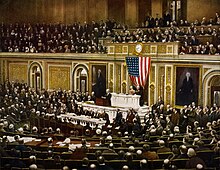
The United States entered into World War I on 6 April 1917, more than two and a half years after the war began in Europe.
Apart from an Anglophile element urging early support for the British and an anti-Tsarist element sympathizing with Germany's war against Russia, American public opinion had generally reflected a desire to stay out of the war. The sentiment for neutrality was particularly strong among Irish Americans, German Americans, and Scandinavian Americans,[1] as well as among church leaders and women in general. On the other hand, even before World War I had broken out, American opinion had been overall more negative toward the German Empire than toward any other country in Europe.[2] Over time, especially after reports of German atrocities in Belgium in 1914 and after the sinking attack by the Imperial German Navy submarine (U-boat) torpedoing of the trans-Atlantic ocean liner RMS Lusitania off the southern coast of Ireland in May 1915, Americans increasingly came to see Imperial Germany as the aggressor in Europe.
While the country was at peace, American banks made huge loans to the Entente powers (Allies), which were used mainly to buy munitions, raw materials, and food from across the Atlantic in North America from the United States and Canada. Although 28th American President Woodrow Wilson (1856–1924, served 1913–1921), made minimal preparations for a land war before 1917, he did authorize a shipbuilding program for the United States Navy. Wilson was narrowly re-elected in 1916 on an anti-war platform.
By 1917, with Belgium and Northern France occupied by German troops, the Russian Empire experiencing turmoil and upheaval in the February revolution overthrowing the Czar on the Eastern Front, and with the remaining Entente Allied nations low on credit, the German Empire appeared to have the upper hand in Europe.[3] However, a British economic embargo and naval blockade were causing severe shortages of fuel and food in Germany. Berlin then decided to resume unrestricted submarine warfare. The aim was to break the trans-atlantic supply chain to Britain from other nations to the West, although the German high command realized that sinking American-flagged ships would almost certainly bring the United States into the war.
Imperial Germany also made a secret offer to help Mexico regain territories of the Mexican Cession of 1849, lost seven decades before in the Mexican–American War of 1846–1848, (now incorporated in the Southwestern United States) in an encoded diplomatic secret telegram known as the Zimmermann Telegram, which was intercepted by British intelligence. Publication in the media of that communique outraged Americans just as German submarines started sinking American merchant ships in the North Atlantic in their U-boat campaign. President Wilson then asked Congress for "a war to end all wars" that would "make the world safe for democracy", and Congress voted to declare war on Germany on April 6, 1917.[4] US troops began major combat operations on the Western Front under General John J. Pershing in the summer of 1918.
- ^ Jeanette Keith (2004). Rich Man's War, Poor Man's Fight: Race, Class, and Power in the Rural South during the First World War. U. of North Carolina Press. pp. 1–5. ISBN 978-0-8078-7589-6.
- ^ Barnes, Harry Elmer. The Genesis of the World War (1926) pp. 590–591
- ^ "World War One". BBC History.
- ^ Link, Arthur S. (1972). Woodrow Wilson and the Progressive Era, 1910–1917. New York: Harper & Row. pp. 252–282.